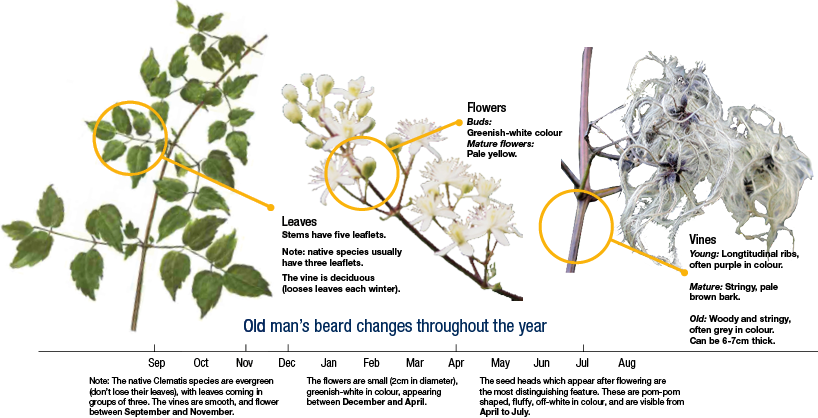-
-
-
-
-
-
-
-
-
-
-
-
-
-
-
Old Man's Beard
-
-
-
-
-

Old Man’s Beard
| Common name: | Old Man’s Beard |
| Scientific name: | Clematis vitalba |
| Management programme: | Progressive containment |
While we’ve got nothing against older men with beards, the plant Old Man's Beard is considered the most damaging climbing plant introduced to New Zealand because it smothers the plants and trees it grows on. This makes it a threat to Otago’s biodiversity. It spreads easily, and stems on the ground can take root and produce new plants. It can produce 1000 seeds per square metre, which stay in the soil or are spread by wind, water and birds. It also grows quickly; a stem can produce up to 10 metres of new growth in a season.
As the name suggests, this vine looks like an old man’s beard. Only when the flowers start maturing though, otherwise they are a greenish-white colour. The young vines have ribs running up and down the vine and mature vines have stringy, pale brown bark. Old vines are woody and stringy, often grey in colour and can be 6-7cm thick. The stems have five leaflets and the plant loses its leaves each winter.
Make sure you don’t confuse Old Man's Beard with native Clematis. The natives usually have only three leaflets per stem (Old Man’s Beard has five) and flower in spring (Old Man’s Beard flowers in summer).
Unfortunately, it grows almost everywhere: gardens, hedges, along roadsides and riverbanks, in native bush, commercial forest and shelter belts. It thrives in the shade and is frost-tolerant.
Everyone in Otago must eliminate Old Man’s Beard on the land they occupy. This is to ensure infestation levels are reduced and threats to environmental values and biodiversity are minimised.
There is also a good neighbour rule for Old Man’s Beard, which states that if your neighbour is controlling Old Man’s Beard within 20m of your shared boundary then you need to be a good neighbour and do the same so efforts are not fruitless.

- Trace the vine back to its roots.
- Either dig out the roots, or cut the vine close to the roots and treat with a herbicide gel or glyphosate-based product. You can get this from a hardware store; make sure you follow the instructions and take relevant health and safety precautions.
- We recommend you leave the cut vine in the tree to break down naturally.
- Don’t leave vines on the ground because they can take root and grow new plants.
Note that vines may need to be re-treated or new seedlings removed.
Tips
- You can leave vines above the cut to break down naturally. This will also prevent damage to the host plant. The vegetation will start to wilt within a few days. Where there's no wilting, start at the live foliage and work back to check for vines you may have missed.
- Take out a section of the vine above the cut stump to ensure hanging vines don't come into contact with the ground, as re-growth may occur.
- Where there are multiple stems, treat all stems or dig out entire root systems.
- Check the stump regularly for re-growth and treat again if needed.
- If it's growing in a hedge and is hard to trace, two people are better than one – one person tugs on the vine and the other person traces it back to the ground.
- If it's growing on a common boundary, talk to your neighbour and deal with the situation together.
If you're unsure of the best approach, contact our biosecurity team at biosecurity@orc.govt.nz – they are happy to give advice.
ORC environmental monitoring officers inspect properties around Otago during the summer months for Old Man’s Beard.
- If non-compliance is found, property owners will be issued with a non-compliance notice.
- A second inspection will take place after 4-5 weeks and if no action has been taken a notice of direction will be issued.
- If no action has been taken by the next inspection in 2-3 weeks, this will be followed by an infringement notice.
ORC environmental monitoring officers are warranted, giving them legal authorisation under the Biosecurity Act to enter properties and inspect for pest plants.























